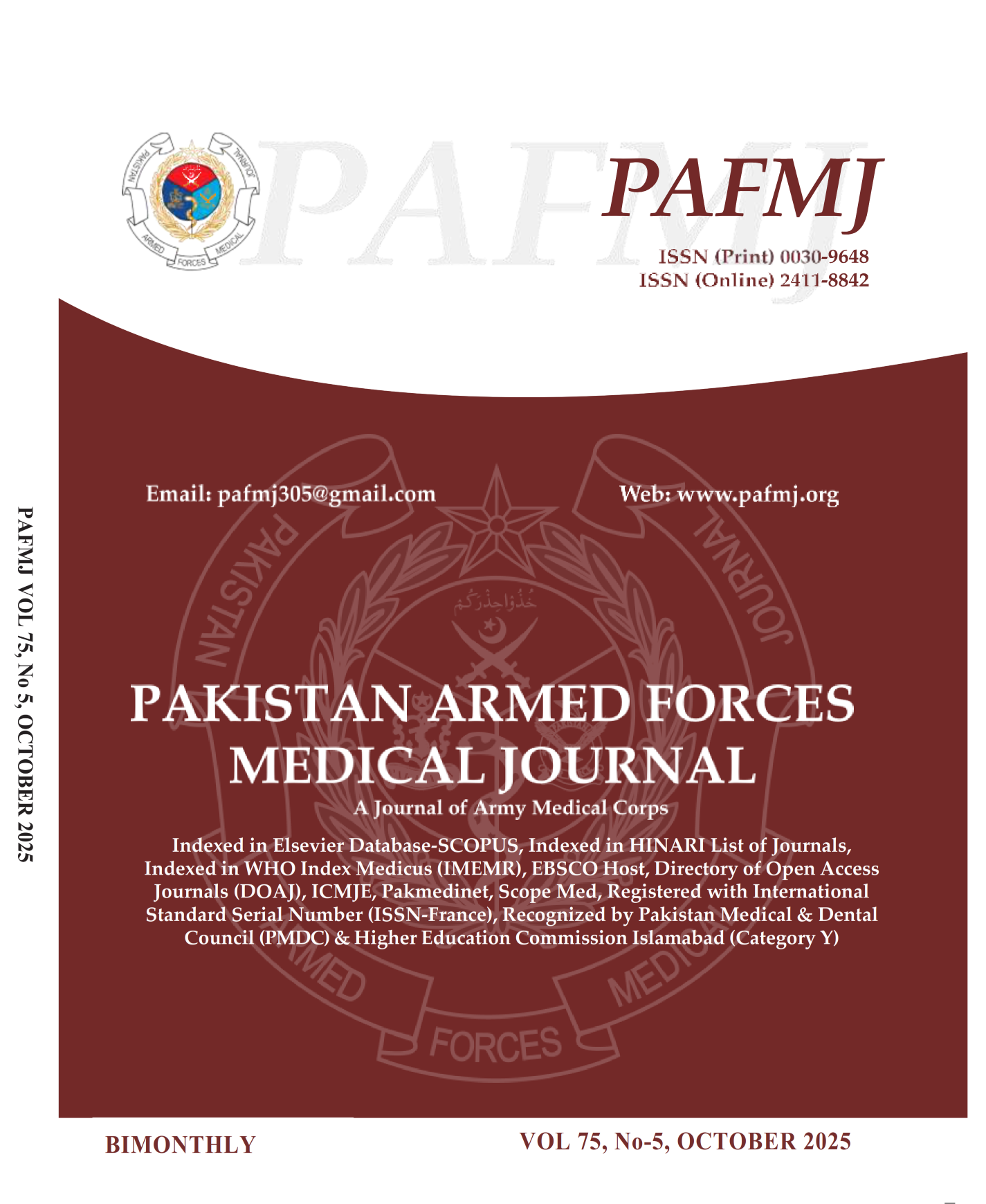Comparison of Maternal and Perinatal Outcome Between 4 cm vs 6 cm Cervical Dilatation at Amniotomy
DOI:
https://doi.org/10.51253/pafmj.v75i5.10959Keywords:
Amniotomy; Cervical dilatation, Induction of laborAbstract
ABSTRACT
Objective: To compare maternal and perinatal outcome between 4 cm vs 6 cm cervical dilatation at Amniotomy among women undergoing induction of labor at our unit.
Study Design: Comparative cross-sectional study.
Place and Duration of Study: Obstetrics Department, Pak Emirates Military Hospital, Rawalpindi Pakistan, from Oct to Dec 2022.
Methodology: This study was conducted on women undergoing induction of labor at our unit. Women participating in this study were divided into two Groups. Group-I had Amniotomy at 4 cm of cervical dilatation while Group-II had Amniotomy at 6 cm of cervical dilatation. Both the Groups were followed up till the delivery for maternal outcome and 12 hours after the delivery for immediate peri-natal outcome. Maternal and perinatal outcomes observed in both Groups were compared for any significant difference.
Results: A total of 634 women with mean age of 28.51±5.51 years meeting the criteria were recruited for this study. Two Groups were made for comparison. 321(50.6%) women had Amniotomy at 4 cm dilatation while 313(49.4%) had Amniotomy at 6 cm dilatation. Statistical analysis showed that when both the Groups were followed up, no statistically significant difference was recorded in any of the maternal or peri-natal outcome parameters included in this study (p-value>0.05).
Conclusion: Induction of labor via Amniotomy could be done effectively both at 4 cm and 6 cm cervical dilatation. Both maternal and perinatal outcome parameters were not significantly different in women undergoing Amniotomy at these two different cervical dilatations in our study.
Downloads
References
1. Al-Wassia H, Saber M. Admission of term infants to the neonatal intensive care unit in a Saudi tertiary teaching hospital: cumulative incidence and risk factors. Ann Saudi Med 2017; 37(6): 420‐424.
https://doi.org/10.5144/0256-4947.2017.420
2. Tang J, Gou W, Fu Y, Li K, Guo X, Huang T, et al. Association between postterm pregnancy and adverse growth outcomes in preschool-age children. Am J Clin Nutr 2022; 116(2): 482-490.
https://doi.org/10.1093/ajcn/nqac127
3. Modrzyńska A, Radoń-Pokracka M, Płonka M. Labor induction at full-term and post-term pregnancies. Folia Med Cracov 2019; 59(4): 79-94. https://doi.org/10.24425/fmc.2019.131382
4. Middleton P, Shepherd E, Morris J, Crowther CA, Gomersall JC. Induction of labour at or beyond 37 weeks' gestation. Cochrane Database Syst Rev 2020; 7(7): CD004945.
https://doi.org/10.1002/14651858.CD004945.pub5
5. Carlson N, Ellis J, Page K, Dunn Amore A, Phillippi J. Review of Evidence-Based Methods for Successful Labor Induction. J Midwifery Womens Health 2021; 66(4): 459-469.
https://doi.org/10.1111/jmwh.13238
6. Wennerholm UB, Saltvedt S, Wessberg A, Alkmark M, Bergh C, Wendel SB, et al. Induction of labour at 41 weeks versus expectant management and induction of labour at 42 weeks (SWEdish Post-term Induction Study, SWEPIS): multicentre, open label, randomised, superiority trial. BMJ 2019; 367(3): l6131. https://doi.org/10.1136/bmj.l6131
7. Kehila M, Abouda HS, Sahbi K, Cheour H, Chanoufi MB. Ultrasound cervical length measurement in prediction of labor induction outcome. J Neonatal Perinatal Med 2016; 9(2): 127-131.
https://doi.org/10.3233/NPM-16915111
8. Pereira S, Frick AP, Poon LC, Zamprakou A, Nicolaides KH. Successful induction of labor: prediction by preinduction cervical length, angle of progression and cervical elastography. Ultrasound Obstet Gynecol 2014; 44(4): 468-475.
https://doi.org/10.1002/uog.13411
9. Rane SM, Guirgis RR, Higgins B, Nicolaides KH. Models for the prediction of successful induction of labor based on pre-induction sonographic measurement of cervical length. J Matern Fetal Neonatal Med 2005; 17(5): 315-322.
https://doi.org/10.1080/14767050500127690
10. Iftakhar T, Qazi N, Malik N, Hamid N, Gul N, Rauf R. Prediction of Successful Induction of Labour jointly using Bishop Score and Transvaginal Sonography in Primigravida Women in Pakistan. Ann Pak Inst Med Sci. 2023; 19(2): 134-137.
11. Li PC, Tsui WL, Ding DC. The Association between Cervical Length and Successful Labor Induction: A Retrospective Cohort Study. Int J Environ Res Public Health 2023; 20(2): 1138.
https://doi.org/10.3390/ijerph20021138
12. Araújo NM, Ochiai AM, Camargo JDCS, Ussame EY, Osava RH, Silva LCFPD. Cervical dilation assessment in simulators compared to a visual tool: A randomized study. Rev Lat Am Enfermagem 2023; 31(3): e3881.
https://doi.org/10.1590/1518-8345.6102.3881
13. Thiele CE, Beckmann M. Induction of labour involving an amniotomy: Waiting compared to immediate oxytocin. Aust N Z J Obstet Gynaecol 2022; 62(5): 795-799.
https://doi.org/10.1111/ajo.13544
14. Njie AE, Nyandiko WM, Ahoya PA, Moutchia JS. A comparative analysis of APGAR score and the gold standard in the diagnosis of birth asphyxia at a tertiary health facility in Kenya. PLoS One 2023; 18(5): e0285828.
https://doi.org/10.1371/journal.pone.0285828
15. Li PC, Tsui WL, Ding DC. The Association between Cervical Length and Successful Labor Induction: A Retrospective Cohort Study. Int J Environ Res Public Health 2023; 20(2): 1138.
https://doi.org/10.3390/ijerph20021138
16. Mohd Fathil N, Abd Rahman R, Mohd Nawi A, Kamisan Atan I, Kalok AH, Mohamed Ismail NA, et al. Comparison of Pregnancy Outcome between 4 and 6 cm Cervical os Dilatation to Demarcate Active Phase of Labour: A Cross-Sectional Study. J Pregnancy 2023; 2023: 8243058.
https://doi.org/10.1155/2023/8243058
17. Rosli AA, Nawi AM, Atan IK, Kalok AM , Ahmad S, Ismail NAM, et al. Cervical dilatation at diagnosis of active phase of labour determines the mode of delivery and peripartum outcomes: a retrospective study in a single tertiary centre in Malaysia. BMC Pregnancy Childbirth 2023; 23(1): 221.
https://doi.org/10.1186/s12884-023-05523-7
18. Shukla D, Shukla S, Patel S, Shah A. Changing Trends in Rate of Cervical Dilation in First Stage of Labor: Prospective Longitudinal Study. Open J Obstret Gynecol 2020; 10(9): 176-186.
Downloads
Published
Issue
Section
License
Copyright (c) 2025 Seema Tariq, Tehreem yazdani

This work is licensed under a Creative Commons Attribution-NonCommercial 4.0 International License.















